Attached files
| file | filename |
|---|---|
| 8-K - FORM 8-K - ASSEMBLY BIOSCIENCES, INC. | v428791_8k.htm |

Assembly Biosciences Nasdaq: ASMB January 2016

C autionary Note Regarding Forward - Looking Statements The information in this presentation contains estimates and other forward - looking statements regarding future events, including statements about the therapeutic potential of our HBV and CDI programs, timing of the initiation of our planned clinical trials in each of these programs, plans, strategies, and intentions related to our programs, and projections regarding capital. Certain forward looking statements may be identified by reference to a future period or periods or by use of forward - looking terminology such as “developing”, “potential,” “projected,” “anticipated”, “positioned,” “strategy,” “should” or “may.” Such forward - looking statements, which we intend to be covered by the safe harbor provisions contained in Section 27A of the Securities Act of 1933, as amended, and Section 21E of the Securities Exchange Act of 1934, as amended, are just predictions and are subject to risks and uncertainties that could cause the actual events or results to differ materially. These risks and uncertainties include, among others: our ability to retain necessary employees and to staff our operations appropriately; the components, timing, cost and results of clinical trials and other development activities involving our product candidates; the unpredictability of the preclinical and clinical development of our product candidates and of the duration and results of regulatory review of those candidates by the FDA and foreign regulatory authorities; our anticipated capital expenditures, our estimates regarding our capital requirements, and our need for future capital; and the possible impairment of, or inability to obtain, intellectual property rights and the costs of obtaining such rights from third parties. These and other potential risks and uncertainties that could cause actual results to differ from the results predicted are more fully detailed under the heading “Risk Factors” in our Annual Report on Form 10 - K for the year ended December 31, 2014, and other reports filed with the Securities and Exchange Commission. It is not possible for Assembly management to predict all risks nor can Assembly assess the impact of all factors on its business or the extent to which any factor, or combination of factors, may cause actual results to differ materially from those contained in any forward - looking statements Assembly may make. In light of these risks, uncertainties and assumptions, the forward - looking events and circumstances discussed in this presentation may not occur and actual results could differ materially and adversely from those anticipated. Except as required by law, we assume no obligation to update publicly any forward - looking statements, whether as a result of new information, future events or otherwise. 2

Investment Highlights An integrated i nfectious disease company Focus on infectious diseases Developing best - in - class small molecules for the treatment of chronic hepatitis B (HBV) Developing drug - like oral microbiotic (MB) therapeutics for the prevention of recurrent C. difficile infection ( rCDI ) World class team Experienced team with 50 employees and 35 FTEs / chemists / consultants MB and HBV program developed with leading scientific experts in discovery, development, manufacturing and delivery Proprietary technologies Novel targets with proprietary chemistry/screening platforms (HBV) Differentiated discovery platform leveraging bacterial strain library and GEMICEL TM oral capsule delivery (MB) Strong financials Funded through inflection points; rapid, capital efficient development Partnership opportunities in non - infectious disease indications Our goal: Create a functional cure for chronic HBV and create a new class of medicines using our proprietary microbiome therapy technologies 3

Experienced Scientific & Leadership Team Proven leadership team producing successful companies & drugs for the past 30+ years Derek A. Small President & CEO Richard Colonno, PhD Chief Science Officer Uri Lopatin , MD CMO & VP R&D Thomas Rollins Chief Development Officer Head of Microbiome Lee Arnold, PhD Chief Discovery Officer David Barrett CFO & COO Additional team members Elizabeth Lacy , GC, VP Legal Operations Micah Mackison , VP Corp Devel . & Strategy Eric Ruby , VP Regulatory & Quality Assurance Wayne Herber , PhD VP Biologics Mfg. & Quality Hongmei Huang, PhD VP of Informatics Mohan Kabadi , PhD VP Mfg. & Process Devel . Leping Li, PhD VP of Discovery Adam Zlotnick , PhD HBV Chief Science Adv. Previous companies Drugs discovered/s ignificant contributions to devel . Gilead, Merck, BMS, Roche, Pfizer, JNJ, Cubist, Vertex, Presidio, Naurex , OSI, BASF, Deloitte, Overture, others entecavir / Baraclude ™ (HBV); r avidasvir (HCV); Incivek ™. (HCV); atazanavir / Reyataz ™ ( HIV); Crixivan ® (HIV); Tarceva ®; Sivestro ®; Zerbaxa ®; Lunesta ® ; Fosamax®, many others 4

HBV Opportunity

HBV Opportunity: More Patients Diagnosed/Treated ~ 240M chronically infected globally – 90M in China (top 5 health priority for s FDA ); > 10M EU; ~ 2M in USA (1) – Current standard of care is not curative in >90% of patients, yet represents >$1B/year market globally and is expected to grow significantly Improvements in diagnostics, greater access to care and heightened awareness are driving increasing number of patients to start therapy HBV in China N umber of patients entering treatment is increasing despite a decreasing population of new patients (1) Kowdley K, Hepatology 2011; 56:422. 93 28 5.6 0.6 89 20 7.5 1.4 76 15 53 13 HBV Carrier Eligible for Treatment Diagnosed Treated 2006 2015 E2025-26 (in millions) 6

ASMB Goal: Curative Therapy for HBV Current therapies are inadequate – Interferons have poor tolerability, efficacy and are not an option for many patients – Polymerase inhibitors are highly effective in inhibiting viral replication and driving viral loads to undetectable levels, but low level viral replication often persists for an extended period 1 – Polymerase inhibitors have no effect on cccDNA levels (key target to eliminate infection) – Multiple year therapy leads to very low cure rates (<10%) To achieve clinical cure, therapy must P revent new cccDNA, I nhibit HBV proteins and E liminate (or silence) existing cccDNA 1. Marcellin et al. Poster 1861, AASLD 2014 7 CURE Eliminate (or Silence) Existing cccDNA Inhibit HBV Proteins Prevent New cccDNA

HBV Core Protein: Required Throughout Lifecycle HBV Core protein ( Cp ) is a non - enzymatic viral protein with no human homologue and is involved in entire HBV viral lifecycle (upstream & downstream) – Believed to play a critical role i n the generation and maintenance of cccDNA – R equired for creating new rcDNA from pgRNA – I mplicated in regulating host immune response 8 • rcDNA : r elaxed circular DNA • cccDNA: covalently closed circular DNA • pgRNA: pre - genomic RNA • RT: reverse transcription

ASMB Progress: AB - 101 to Prevent cccDNA Strong patent position on CpAMs (Core protein Allosteric Modifiers ) compositions and uses for HBV Potent lead series – Alters Cp oligomer conformation • Reduces pgRNA packaging • Inhibits rcDNA formation • Reduces rcDNA delivery to nucleus – Prevents synthesis of new cccDNA Profile of first candidates – Potent, pan - genotypic activity (EC 50 20 - 200nM) across multiple viral genotypes (A - D) – Highly favorable drug characteristics and PK profile in multiple species – IND - enabling studies underway Pursuing multiple series of CpAMs to exploit distinct Cp functions – Optimizing SAR for upstream - acting compounds – Multiple active series under evaluation 9 Significant progress in 2015 – building R&D engine
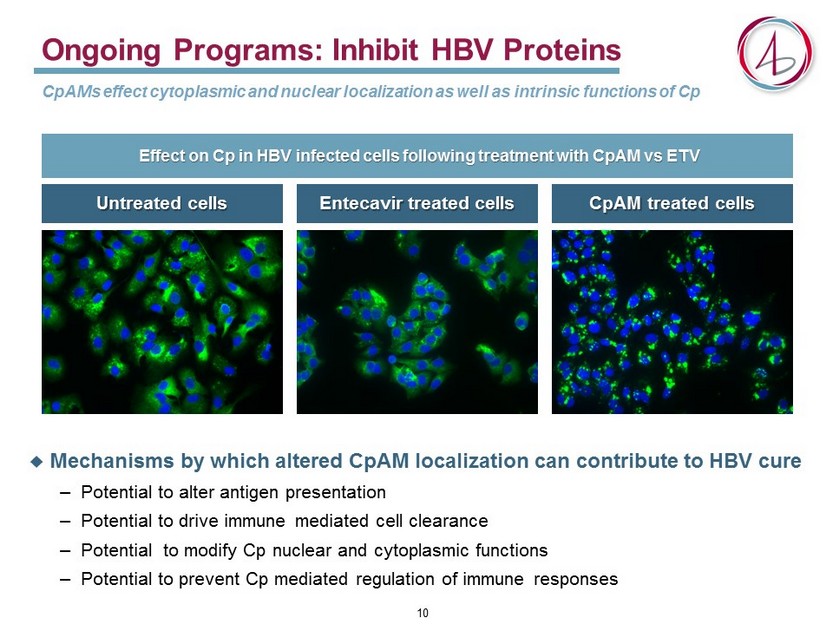
Ongoing Programs: Inhibit HBV Proteins CpAMs effect cytoplasmic and nuclear localization as well as intrinsic functions of Cp Untreated cells Entecavir t reated c ells CpAM t reated c ells Mechanisms by which altered CpAM localization can contribute to HBV cure – Potential to alter antigen presentation – Potential to drive immune mediated cell clearance – Potential to modify Cp nuclear and cytoplasmic functions – Potential to prevent Cp mediated regulation of immune responses Effect on Cp in HBV infected c ells f ollowing t reatment with CpAM vs ETV 10
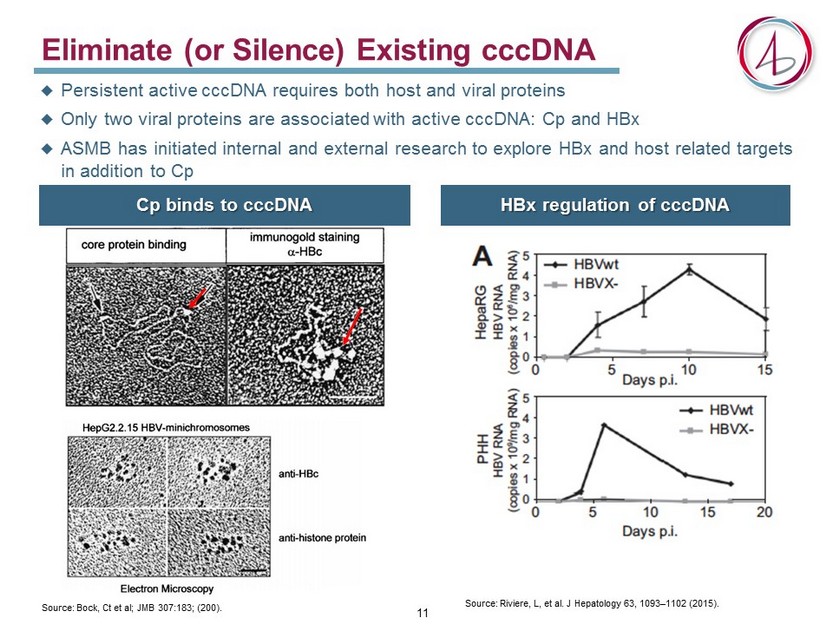
Eliminate (or Silence) Existing cccDNA Persistent active cccDNA requires both host and viral proteins Only two viral proteins are associated with active cccDNA: Cp and HBx ASMB has initiated internal and external research to explore HBx and host related targets in addition to Cp Source: Bock , Ct et al; JMB 307:183; (200 ) . Cp binds to cccDNA HBx regulation of cccDNA • Source: Riviere , L, et al. J Hepatology 63 , 1093 – 1102 (2015). 11

ASMB HBV Pipeline & Projected Timeline 2015 2016 2017 Therapeutics 1st generation HBV CpAM 2 nd generation HBV CpAM HBV upstream mechanism HBV upstream mechanism Novel target(s) Ph 1a/1b IND enabling s tudies Candidate selection Ph 1a/1b IND enabling studies Candidate selection IND enabling Candidate selection Research 12 Research Research Ph 2 Candidate selection Research CURE Eliminate (or Silence) Existing cccDNA Inhibit HBV Proteins Prevent New cccDNA
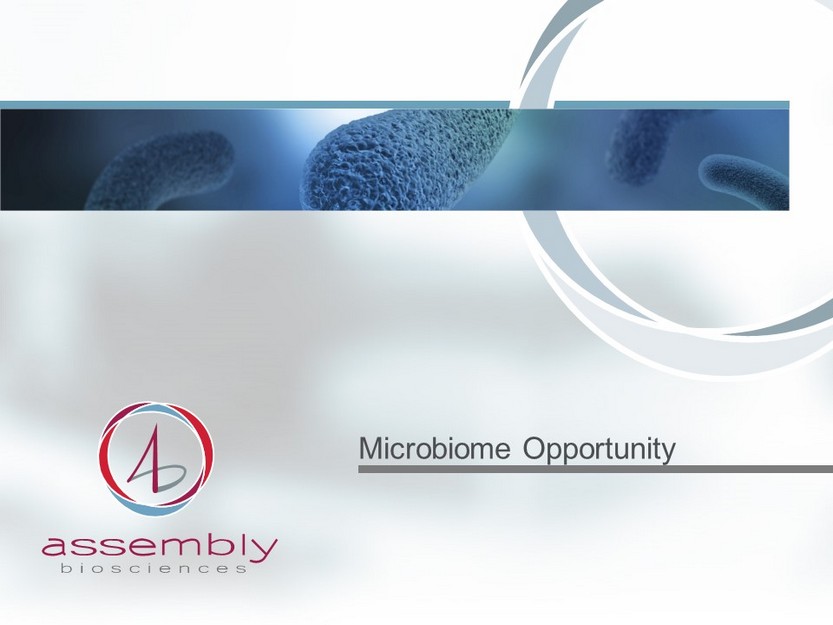
Microbiome Opportunity

~500,000 cases of CDI yearly, 77% higher chance of being readmitted within 30 days, 55% longer hospital stay and 13% higher risk of mortality Dysbiotic microbiome linked to multiple diseases Microbiome Opportunity: FMT as a Starting Point 14 - Irritable b owel syndrome (IBS) - Metabolic disease - Other indications (CNS; cancer ) - Primary CDI - Other infectious diseases - Inflammatory bowel d isease (IBD)

Fecal Microbiota Transplant Works , But ….. Widespread adoption of fecal microbiota transplantation (FMT) is problematic FMT is a procedure not a product FMT is a true transplant of human - derived biological material Risks of infection transmission can’t be fully resolved Poor patient and health care worker acceptance – “…you want to put…. WHAT into me?” Batch to batch inconsistency 15 A better approach is needed: Replace FMT with a product

ASMB’s Proposed Solution : ‘Druggable’ Microbes Replace FMT with microbiotic therapy What success in replacing FMT looks like – An oral “biologic” pill – Efficacy that meets or exceeds FMT response Assembly program plans to combine two differentiated components – cGMP production of systematically - selected strains of therapeutic bacteria should allow for consistent product – GEMICEL ™ platform technology; allows for targeted delivery of select strains of vegetative bacteria (both spore formers and non - spore formers) directly in the colon 16

GEMICEL™ Formulation Our proprietary targeted delivery technology enables direct treatment in the colon Controlled release p latform Targeted d elivery Second inner c oated for bolus release of drug A in right colon First outer c oated for bolus release of drug A in ileum • GRAS ingredients • Manufacturing amenable to biologic products Despite challenges, the colon is an attractive site for drug delivery and especially for microbiotic delivery IF it can be reliably delivered Small intestine: complex pH and physiology Large intestine: c omplex flora 1.5M 6 meters GI tract has number of defenses that make colonization challenging 17

Rigorous scientific development engine for bacterial therapy selection Integrated Discovery & Manufacturing Engine Proprietary selection methodologies Human FMT studies Scientifically rigorous sequencing and analysis including machine based algorithms in vitro and in vivo models Systems that assure proper design, monitoring and control of selected strains require Isolation Development of appropriate culture media & cultivation conditions GMP cell banking of pure strains GMP production of bulk material Scale up Strain Selection Development / Manufacturing Targeted Delivery GEMICEL TM designed to enable reliable targeted delivery of otherwise “undeliverable” microbes while providing flexibility for single or multi - day regimens to optimize efficacy across multiple indications 18

Efficacy : AB - M101 oral capsules will incorporate select strains of vegetative bacteria to achieve similar efficacy and safety as FMT in the treatment of rCDI – We believe that a therapy including both spore and non - spore forming bacteria, delivered specifically to the lower GI tract, can be best in class for treatment of multiple types of intestinal dysbiosis Regulatory/cGMP: Anticipate that AB - M101 will be scalable, cost efficient, reliable and consistent Patient Preference: Oral treatment with dosing flexibility more acceptable to patients and may provide a better chance of efficacy/non - recurrence Initial focus: AB - M101 as a best - in - class therapy for treatment of rCDI MB Anticipated Clinical Candidate For rCDI 19
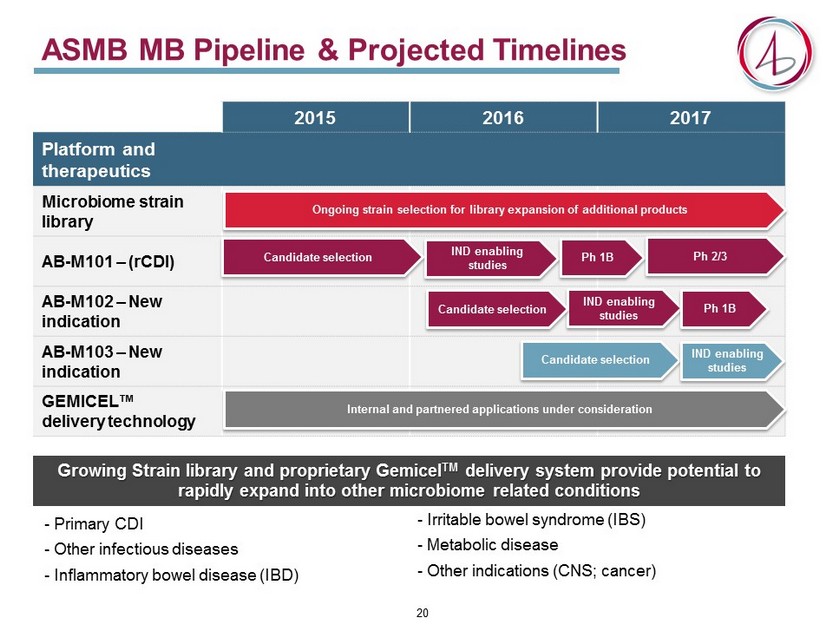
ASMB MB Pipeline & Projected Timelines 2015 2016 2017 Platform and therapeutics Microbiome strain library AB - M101 – ( rCDI ) AB - M102 – New indication AB - M103 – New indication GEMICEL™ d elivery technology Ongoing strain selection for library expansion of additional products IND enabling studies Ph 1B Ph 2/3 Candidate selection IND enabling studies Candidate selection Ph 1B 20 I nternal and partnered applications under consideration Candidate selection IND enabling s tudies Growing Strain library and proprietary Gemicel TM d elivery system provide potential to rapidly expand into other microbiome related conditions - Primary CDI - Other infectious diseases - Inflammatory bowel disease (IBD) - Irritable b owel syndrome (IBS) - Metabolic disease - Other indications (CNS; cancer )

Financial Summary 21 21 Strong Base Of Biotech Investors Baker Brothers Nasdaq ASMB Cash, cash equivalents & marketable securities ~$97M as of September 30, 2015 Shares outstanding ~17.2M Fully diluted ~20.4M
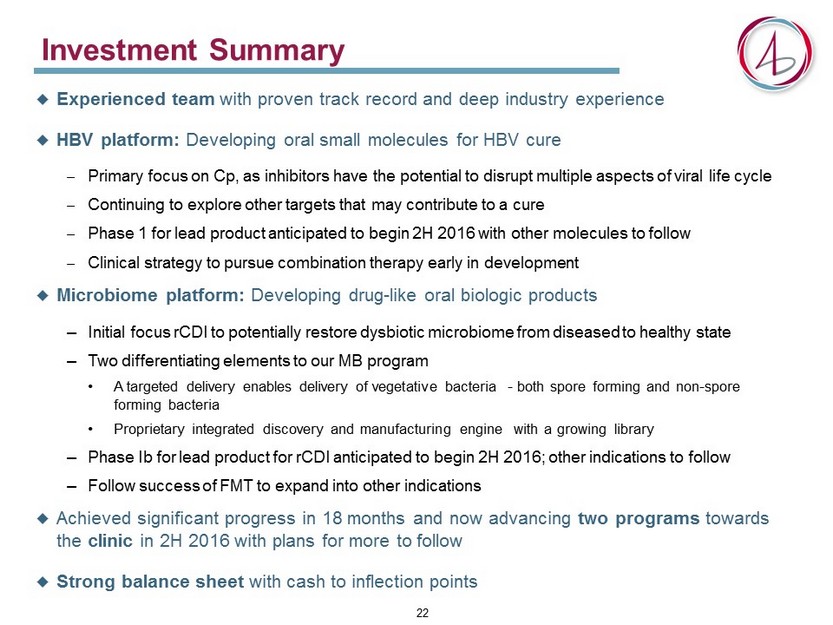
Investment Summary Experienced team with proven track record and deep industry experience HBV platform : D eveloping oral small molecules for HBV cure – Primary focus on Cp , as inhibitors have the potential to disrupt multiple aspects of viral life cycle – Continuing to explore other targets that may contribute to a cure – Phase 1 for lead product anticipated to begin 2H 2016 with other molecules to follow – Clinical strategy to pursue combination therapy early in development Microbiome p latform : Developing drug - like oral biologic products – Initial focus rCDI to potentially restore dysbiotic microbiome from diseased to healthy state – Two differentiating elements to our MB program • A targeted delivery enables delivery of vegetative bacteria - both spore forming and non - spore forming bacteria • P roprietary integrated discovery and manufacturing engine with a growing library – Phase Ib for lead product for rCDI anticipated to begin 2H 2016; other indications to follow – Follow success of FMT to expand into other indications Achieved significant progress in 18 months and now advancing two programs towards the clinic in 2H 2016 with plans for more to follow Strong balance s heet with cash to inflection points 22
